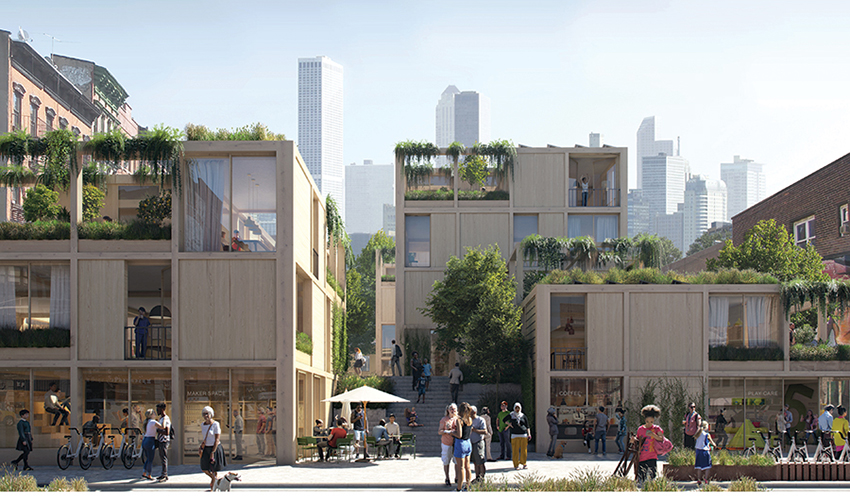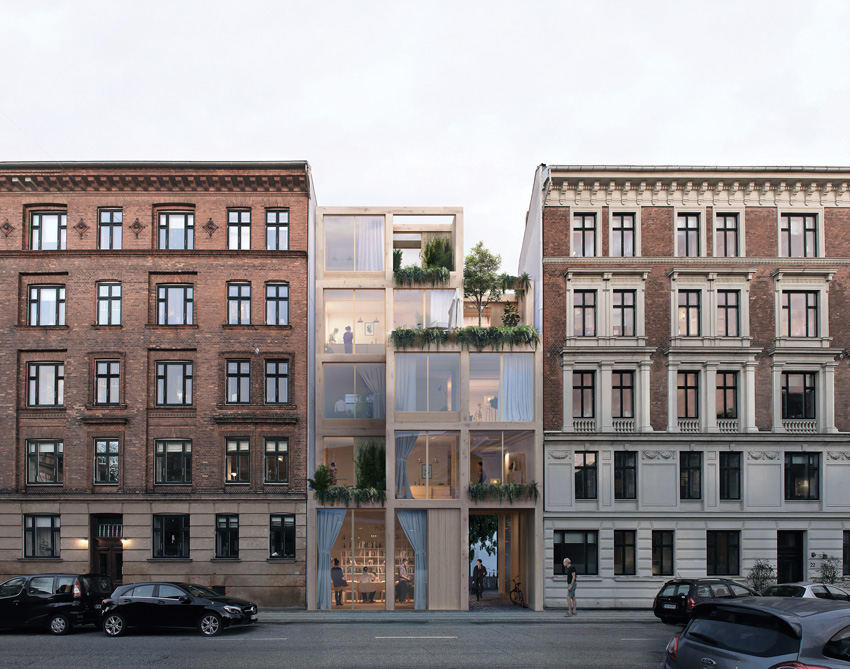Modular Construction
The firm designed a prototypical building using wood-framed volumetric construction that could be replicated across multiple sites. It comprises 52 320-square-foot units on three stories. Intended to be demountable and relocatable to allow for temporary installations while longer-term plans for a site evolve, the buildings use a space-frame foundation system to save the time—and cost—of extensive site work. As well as shelter, each building provides support services to help residents change the circumstances that led to their homelessness. Facade accents in yellow highlight common areas such as kitchens, dining and social rooms, and other support spaces.

IMAGE: COURTESY SKENDER; DAVID BAKER ARCHITECTS
Boni Maddison Architects has developed more than 600 units for the formerly homeless on 10 different sites in Vancouver. The projects, which depend on wood-framed volumetric construction, were completed in less than 18 months.
In addition to their rapid response, it might be expected that modular units would also save money. But Boni reports that these projects came in at costs comparable to site-built. At David Baker Architects (DBA), a San Francisco–based firm with more than a decade’s experience with modular construction, associate Brad Leibin says that savings from prefabrication typically amount to five to 10 percent of total project costs, although Larry Pace, COO at Factory OS, a Bay Area volumetric prefabricator, reports savings of as much as 20 percent of total costs, as does Skender.
The challenge is that, even though prefabricated components account for most of the superstructure, other elements, such as site work, foundation, on-site connections, and exterior finishes, typically account for about two-thirds of total project costs, says Leibin; “Achieving savings with modular construction depends in large part on designing to minimize site work.” A key strategy is to minimize connections across modules—and therefore on-site patchwork and additional trades and traffic. If a one-bedroom apartment, for example, consists of two volumetric modules side by side, configuring the program so that the seam between the two modules is primarily wall (rather than the middle of a room, say, or lots of doorways and cross-unit service connections) reduces the need for on-site finishing. Understanding the way units will be built is essential from the outset, as is a prototype before fabrication starts.
Clearly distinguishing work to be performed in the factory from work to be completed on-site is another way to keep costs down. If a drawing contains both types of scope, DBA typically provides side-by-side versions, one graying out the factory work to highlight the on-site scope, and the other doing the reverse. This way, state officials reviewing prefabricated components and municipal regulators reviewing site work (which is how approvals for modular construction are structured in California) can see their scope clearly, and trades who may be unfamiliar with prefabrication don’t feel the need to allow for uncertainties by overbidding.
“At least half of the clients coming through our door are interested in the possibility of modular,” says Leibin. The firm works with them to assess whether their project and prefabrication are a good fit, evaluating factors such as financing timelines (prefabrication typically requires capital earlier in the process), cost- and time-saving opportunities, and site constraints (such as whether streets are wide enough to accommodate volumetric modules and whether there’s an appropriate staging area nearby). “Our goal is the best building possible within a given budget,” says Leibin, “and modular construction is a possible tool for achieving that.”


RENDERINGS: BY EFFEKT ARCHITECTS FOR SPACE10
The Urban Village system developed by EFFEKT and SPACE10 is intended to be adaptable to different site conditions and varying scales, including an urban infill building (above) and a city district (top).
In one of the most comprehensive approaches to prefabrication so far, EFFEKT Architects’ IKEA-funded design leverages the potential of modular housing to tackle multiple aspects of the housing crisis head on. “We’ve seen a wide range of sustainable projects that are not affordable and maybe not livable, cities that are consistently ranked most livable, but are neither sustainable nor affordable, and a long tradition of affordable housing that is neither livable nor sustainable,” says Sinus Lynge. “We believe that unless you combine all three, you don’t really crack the code. That’s what we’re trying to do with this project.”
The resulting scheme for the Urban Village Project consists of a mass-timber system that can be configured to achieve site-specific projects of varying scales, from a single infill building to community-scale developments of 50 units or so, and even projects comprising multiple communities. Interchangeable facade elements—windows, balconies, and wall panels—generate variety, while their mechanical connections facilitate retrofitting and reuse in a circular supply chain. Shared spaces and resources foster community, and a range of apartment sizes and configurations supports diverse household types and aging in place.
Beyond the building fabric, the scheme addresses affordability with a financing model targeted toward long-term investors, as well as an innovative “subscription” program. At a minimum, residents subscribe to a monthly rate that includes such essentials as rent, utilities, and maintenance. In addition, they can choose to subscribe to deals on food, media, insurance, transportation, and recreation. And they also have the option each month of buying shares in the development, accessing ownership progressively without the need to accumulate what’s often a prohibitive down payment or to pay interest on a mortgage.
The Urban Village Project is now out for feedback and expressions of interest from investors, developers, municipalities, and the public, with a prototype scheduled for later this year. “The ambition is to rethink the way we build modular,” says Lynge—an aspiration that resonates among the growing number of architects and industry professionals who think the housing sector is ripe for this change.
Katharine Logan is an architectural designer and writer focusing on design, sustainability, and well-being.
Supplemental Materials
Modular Construction: From Projects to Products; McKinsey & Company, June 2019; Nick Bertram, Steffen Fuchs, Jan Mischke, Robert Palter, Gernot Strube, and Jonathan Woetzel; “In brief,” (page 1) and “Modular has had its moment before, but there is reason to believe its momentum is sustainable this time,”(pages 17 through 19).








